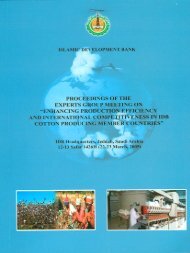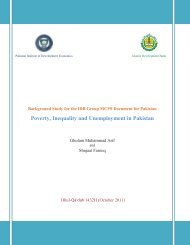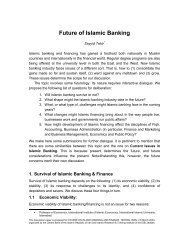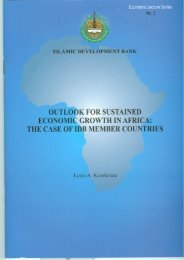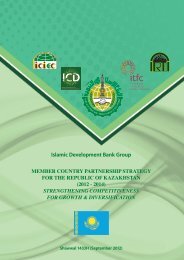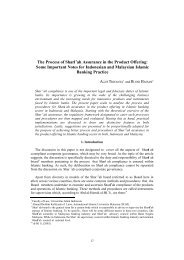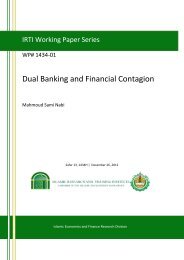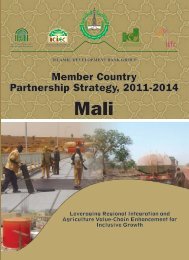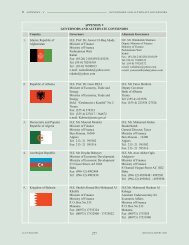Country Economic Work for Malaysia - Islamic Development Bank
Country Economic Work for Malaysia - Islamic Development Bank
Country Economic Work for Malaysia - Islamic Development Bank
Create successful ePaper yourself
Turn your PDF publications into a flip-book with our unique Google optimized e-Paper software.
(2006-2010) but its annual average growth rate remained 4.2%. Compared to 11 high growth<br />
per<strong>for</strong>ming Asian countries (China, India, Singapore, Korea Republic, Vietnam, Hong Kong,<br />
Taiwan, Indonesia, Thailand, and Philippines), <strong>Malaysia</strong> was at the 3 rd position (after China and<br />
Singapore) in terms of high growth during 1990s but over the last decade its momentum of<br />
growth noticeably slowed and its ranking moved to 7 th position, while the growth rates of several<br />
other countries in the region have improved during 2000s.<br />
22. Keeping in view the deceleration in growth during 2000s, it is important to find out what<br />
are the major causes and binding constraints to <strong>Malaysia</strong>n’s sustainable growth, using an<br />
appropriate growth diagnostic framework, which is described as follows.<br />
i. Growth Diagnostic Framework<br />
23. The widely used Growth Diagnostic Framework developed by Hausmann, Rodrik,<br />
and Velasco (2005), which considers low level of private investment as the only binding<br />
constraint, to economic growth, while ignoring the role of public investment and software of<br />
growth in achieving sustainable economic development. In this study, Hausmann, Rodrik, and<br />
Velasco framework is extended by including all the possible sources of economic growth (i.e.<br />
public investment, private investment and software of growth). The IDB Group MCPS Team <strong>for</strong><br />
<strong>Malaysia</strong> has developed the problem tree, which provides a complete framework <strong>for</strong> diagnosing<br />
critical constraints to sustainable economic growth in <strong>Malaysia</strong> (Figure 1.12).<br />
24. The Growth Diagnostic Framework starts with private investment: First, it starts by<br />
asking what keeps the level of private investment low. Is private investment low due to low return<br />
on investment or high cost of financing? If it is low because of low social returns, is that due to<br />
poor geography (natural disasters) or poor human capital or physical infrastructure? If the<br />
problem is poor appropriately, is it due to government failures, market failures or both? If it is<br />
government failure, is that due to micro risks (i.e. high cost of doing business), macro risks (i.e.<br />
financial, monetary and fiscal instability) or restriction on <strong>for</strong>eign ownership <strong>for</strong> the <strong>for</strong>eign<br />
investors? If the impediment on private investment is due to high cost of financing, is that due to<br />
bad international finance (i.e. high interest rate and stringent conditionalities) or shortage of local<br />
finance. If the problem is of bad local finance, is that due to low private saving or poor<br />
intermediation of the banking system. 8<br />
25. Starting from the second part of the problem tree with regard to low level of public<br />
investment, it starts by asking what keeps the level of public investment low. Is public<br />
investment low because of budgetary constraints, leakages, or limited implementation capacity?<br />
If it is due to budgetary constraint, is it because of tight fiscal position, high borrowing cost or<br />
other development priorities? Are the leakages due to corruption or poor governance? Is limited<br />
implementation capacity due to weak institutions or poor human capital?<br />
8 For further detail on the Growth Diagnostic Framework, see Iqbal Z. and A. Suleman (July 2010), “Indonesia: Critical<br />
Constraints to Infrastructure <strong>Development</strong>”, and ADB-IDB-ILO (2010), Joint <strong>Country</strong> Diagnostic Study on “Indonesia:<br />
Critical <strong>Development</strong> Constraint”.<br />
13







